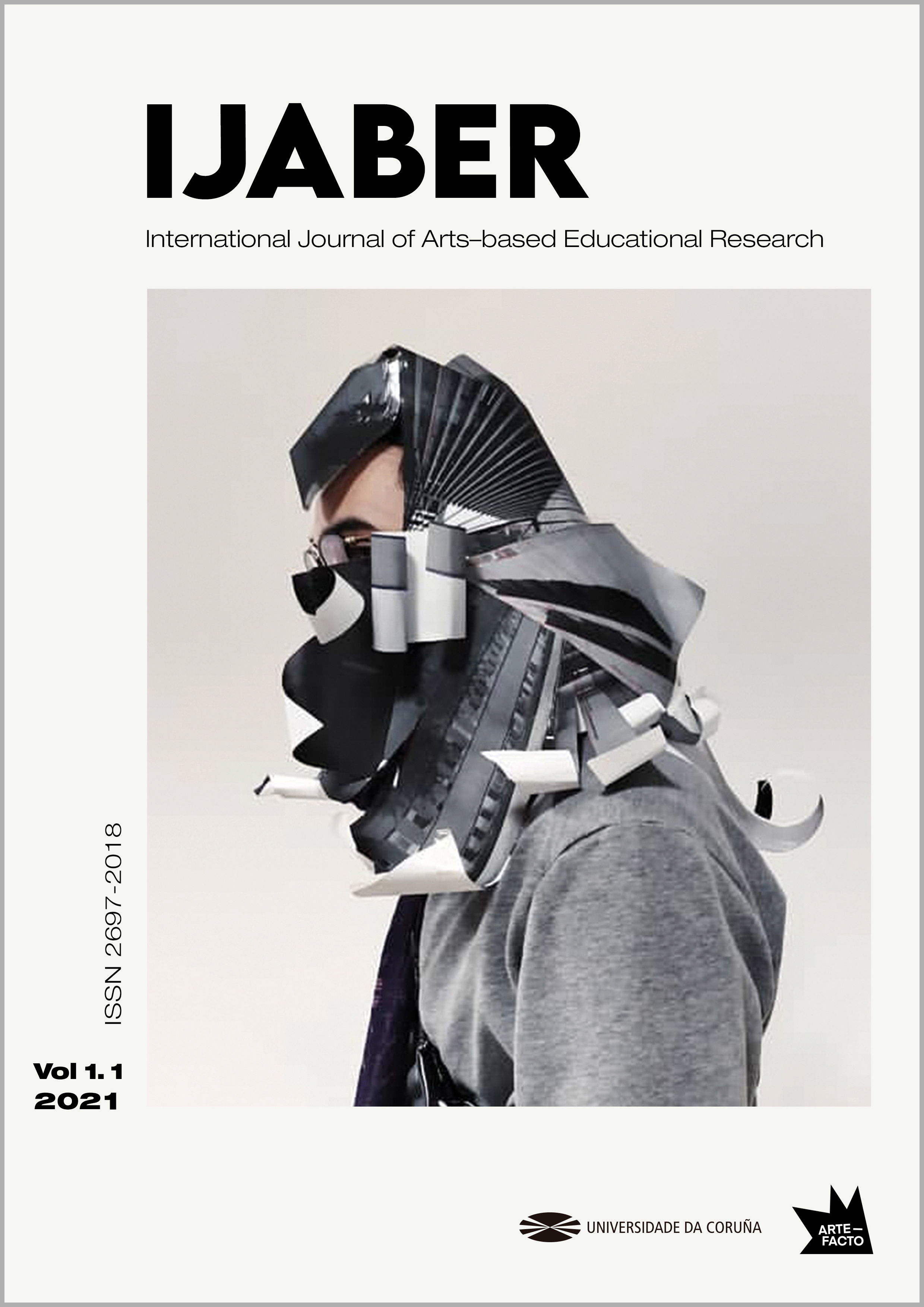Nuevas posibilidades del dibujo técnico a través de una investigación educativa basada en las artes Aproximación a la Moda Surrealista a través de las perspectivas imposibles de M.C. Escher
Contenido principal del artículo
DOI:
https://doi.org/10.17979/ijaber.2021.1.1.7599Resumen
Este artículo muestra una investigación educativa basada en las artes en la formación del profesorado (2017-2020) realizada para la asignatura “Aprendizaje y Enseñanza del Dibujo Técnico” del Máster en Profesorado de Educación Secundaria Obligatoria y Bachillerato, Formación Profesional y Enseñanza de Idiomas, en la especialidad de Dibujo, Imagen y Artes Plásticas (Universidad de Almería). Los perfiles del alumnado son dispares: arquitectos, ingenieros técnicos, diseñadores gráficos, licenciados en Bellas Artes, licenciados en Historia del Arte, en Publicidad, Moda y Relaciones Públicas, por lo que los procesos son, al mismo tiempo, muy complejos, pero muy enriquecedores, aportando nuevas perspectivas a los enfoques de la enseñanza-aprendizaje del Dibujo Técnico.
Se ha desarrollado una metodología de investigación artística participativa, colaborativa, creativa y experimental en formato de laboratorio con la idea de diseñar programas o, mejor dicho, experiencias, que estimulen el interés del alumnado y la investigación autónoma del mismo.
Se pretende abordar el estudio de la representación gráfica y del espacio mediante nuevas vías que acompañen al dibujo técnico y se vean reflejadas en las inquietudes de los discentes, como puede ser, en este caso en particular, el mundo de la Moda. Pero también es importante saber y entender que esta materia puede conducirnos al mundo del Teatro, el Constructivismo o el Video Mapping.
Palabras clave:
Detalles del artículo
Referencias
Arheim, R. (2005). Arte y percepción visual. Madrid: Alianza Editorial.
Barraza, A. y Silerio, J. (2012). Indefensión escolar aprendida en alumnos de educación media superior y su relación con dos indicadores del desempeño académico. Psicogente, 15 (28), 337-347. http://revistas.unisimon.edu.co/index.php/psicogente/article/view/1880
Baudot, F. (2003). Moda y surrealismo. Madrid: H. Kliczkowski.
Berrater, B., Santos, J. D. y Ferrater, C. (comp.) (2011). M.C. Escher. Infinite Universes. (Exposición celebrada en Granada, Parque de las Ciencias, del 29-III-2011 al 08-I-2012). Granada: Gráficas Alhambra.
Bruner, J. (2001). El proceso mental en el aprendizaje. Madrid: Narcea.
Caeiro-Rodríguez, M. (2018). Aprendizaje Basado en la Creación y Educación Artística: proyectos de aula entre la metacognición y la metaemoción. Arte, individuo y sociedad, 30 (1), 159-177.
Camargo, A. y Hederich, C. (2010, diciembre). Jerome Bruner: dos teorías cognitivas, dos formas de significar, dos enfoques para la enseñanza de la ciencia. Psicogente, 13 (24), 329-346.
Casablanca, L. (2007). La moda como disciplina artística en España. Jesús del Pozo y la generación de los nuevos creadores [Tesis Doctoral]. Universidad de Granada.
D. Efland, A., Freedman, K. y Stuhr, P. (2003). La educación en el arte posmoderno. Barcelona: Editorial Paidós.
Fernández, A. y Martín, G. (2009). Dibujo para diseñadores de Moda. Barcelona: Parramón.
García-Valcárcel. A, Basilotta, V. y López, C. (2014). Las TIC en el aprendizaje colaborativo en el aula de Primaria y Secundaria. Comunicar, XXI (42), 65-74. https://www.redalyc.org/articulo.oa?id=158/15830197008
Gómez Molina, J. J., Cabezas, L. y Bordes, J. (2003). El manual de dibujo. Estrategias de su enseñanza en el siglo XX. Madrid: Cátedra.
López, V (coord.) (2009). Perspectiva. Ciencia y magia de la representación. (Exposición celebrada en Granada, Parque de las Ciencias, diciembre 2008 a septiembre 2099). Granada: Gráficas Alhambra.
Lurie, A. (2002). El lenguaje de la moda. Una interpretación de las formas de vestir. Barcelona: Editorial Paidós.
Maestú, F., Ríos, M. y Tiraou, J. (2008). Manual de Neuropsicología (2ª ed.). Barcelona: Viguera.
Mesías Lema, J. M. (2017). Art Teacher Training: a photo essay. International Journal of Education through Art, 13 (3), 395-404. https://doi.org/10.1386/eta.13.3.395_1
Mesías Lema, J. M. (2019). ARTISTAS HABITANTES: una metodología contemporánea, participativa y colectiva en Educación Artística. Observar 2019. 13, 74-104. https://www.observar.eu/ojs/index.php/Observar/article/view/104
Mesías Lema, J. M. (2019). Educación artística sensible. Cartografía contemporánea para arteducadores. Barcelona: Editorial GRAÓ.
Pallasmaa, J. (2014). Los ojos de la piel: la arquitectura y los sentidos (2.ª ed.). Barcelona: Gustavo Gili.
Palmegiani, M (2018). Elsa Chiaparelli y su relación con el Surrealismo. Revista anual de Historia del Arte. Liño, 24, 73-84.
Polaino-Lorente, A. y Vázquez, C. (1982). La indefensión aprendida: ¿Un modelo experimental de depresión? Revista del Departamento de Psiquiatría de la Facultad de Medicina de Barcelona, 3, 173-195. http://opendata.dspace.ceu.es/handle/10637/1905
Real Decreto 1105/2014, de 26 de diciembre, por el que se establece el currículo básico de la Educación Secundaria Obligatoria y del Bachillerato. Boletín Oficial del Estado, núm. 3, del 3 de enero de 2015. https://www.boe.es/buscar/act.php?id=BOE-A-2015-37
Squicciarino, N. (2012). El vestido habla, consideraciones psico-sociológicas sobre la indumentaria. Madrid: Cátedra, Signo e imagen.
Szkutnicka, B. (2010). El dibujo técnico de moda paso a paso. Barcelona: Gustavo Gili.
Torres, R. (2009) Aplicación de la metodología Interactiva del dibujo técnico en la enseñanza secundaria con el programa Cabri 2D- 3D. [Tesis Doctoral]. Universidad Politécnica de Valencia.
Vanrell, C. R. (2007). Creación artística en la adolescencia: vinculaciones terapéuticas/Artistic creation in adolescence: therapeutic entailments. Arteterapia, 2, 247-260.



